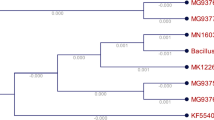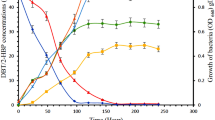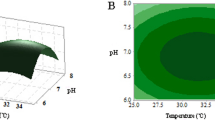Abstract
Bacterial strain Delftia sp. TBKNP-05, isolated by para-hydroxybenzoate enrichment technique, is capable of degrading di-n-butylphthalate (DBP) as a sole source of carbon and energy. Analysis of intermediates by thin-layer chromatography and high-performance liquid chromatography indicated the presence of monobutylphthalate (MBP), phthalate (PA), and protocatechuate (PCA). The washed cells grown on DBP and PA showed appreciable oxidation of DBP, MBP, PA, and PCA. The enzyme activities in cell-free extracts of Delftia sp. TBKNP-05 exhibited the presence of DBP esterase, MBP esterase, PA-dioxygenase, and PCA 4,5-dioxygenase. The PCA is metabolized by meta-cleavage pathway, leading to further mineralization of the compound in this bacterium.


Similar content being viewed by others
Literature Cited
Chang HK, Zylstra GJ (1998) Novel organization of the genes for phthalate degradation from Burkholderia cepacia DBO1. J Bacteriol 180:6529–6537
Cole JR, Chai B, Farris RJ, Wang Q, Kulam SA, McGarrell DM, et al. (2005) The Ribosomal Database Project (RDP-II): Sequences and tools for high-throughput rRNA analysis. Nucleic Acids Res 1:33
Eaton RW (2001) Plasmid encoded phthalate catabolic pathway in Arthrobacter keyseri 12B. J Bacteriol 183:3689–3703
Eaton RW, Ribbons DW (1982) Metabolism of dibutylphthalate and phthalate by Micrococcus sp. strain 12B. J Bacteriol 151:48–57
Jianlong W (2004) Effect of di-n-butyl phthalate (DBP) on activated sludge. Proc Biochem 39:1831–1836
Karegoudar TB, Pujar BG (1984) Metabolism of diethylphthalate by a soil bacterium. Curr Microbiol 11:321–324
Keith LH, Telliard WA (1979) Priority pollutants. I: A perspective view. Environ Sci Technol 13:416–423
Kim YH, Lee J, Ahn JY, Gu MB, Moon SH (2002) Enhanced degradation of an endocrine disrupting chemical butyl benzyl phthalate by Fusarium oxysporium f. sp. pisi cutinase. Appl Environ Microbiol 68:4684–4688
Kim YH, Lee J, Moon SH (2003) Degradation of endocrine disrupting chemical DEHP [di-(ethylhexyl)-phthalate] by Fusarium oxysporum f. pisi cutinase. Appl Microbiol Biotechnol 63:75–80
Kleerebezem R, Pol LWH, Lettinga G (1999) Anaerobic biodegradability of phthalic acid isomers and related compounds. Biodegradation 10:63–73
Kumar S, Tamura K, Jakobsen IB, Nei M (2001) MEGA2: Molecular Evolutionary Genetics Analysis Software. Bioinformatics 17:1244–1245
Lowry OH, Rosebrough NJ, Farr AL, Randall RJ (1951) Protein measurement with folin-phenol reagent. J Biol Chem 193:265–275
Macdonald DL, Stanier RY, Ingrahm JL (1954) The enzymatic formation of B-carboxymucomic acid. J Biol Chem 210: 809–820
Manohar S, Kim CK, Karegoudar TB (1999) Degradation of anthracene by a Pseudomonas strain NGK1. J Microbiol 37:73–79
Niazi JH, Prasad DT, Karegoudar TB (2001) Initial degradation of dimethylphthalate by esterases from Bacillus species. FEMS Microbiol Lett 196:201–205
Ono K, Nozaki M, Hayaishi (1970) Purification and some properties of protocatechuate 4,5-dioxygenase. Biochem Biophys Acta 220:224–238
Patil NK, Karegoudar TB (2005) Parametric studies on batch degradation of a plasticizer di-n-butylphthalate by immobilized Bacillus sp. World J Microbiol Biotechnol 21:1493–1498
Pidiyar VJ, Jangid K, Patole MS, Shouche YS (2004) Studies on cultured and uncultured microbiota of wild Culex quinquefasciatus mosquito midgut based on 16s ribosomal RNA gene analysis. Am J Trop Med Hyg 70:597–603
Quan CS, Liu Q, Tian WJ, Kikuchi J, Fan SD (2005) Biodegradation of an endocrine-disrupting chemical, di-2-ethylhexylphthlate, by Bacillus subtilis no.66. Appl Microbiol Biotechnol 66:702–710
Rothera ACH (1908) Note on the sodium nitroprusside reaction for acetone. J Physiol 37:491–494
Sambrook J, Fritsch EF, Maniatis T (1989) Molecular cloning: A laboratory manual, 2nd ed. Cold Spring Harbor, NY: Cold Spring Harbor Laboratory Press
Staples CA, Peterson DR, Parkerton TF, Adams WJ (1997) The environmental fate of phthalate esters: A literature review. Chemosphere 4:667–749
Teil MJ, Blanchard M, Chevreuil M (2005) Atmospheric fate of phthalate esters in an urban area (Paris-France). Sci Total Environ 354:212–223
United States Environmental Protection Agency (1982) Fate of priority pollutants in publicly owned treatment works. Final report EPA 440/1–82/303
Xu XR, Li HB, Gu JD (2005) Biodegradation of an endocrine disrupting chemical di-n-butylphthlate ester by Pseudomonas fluorescens B-1. International Biodeterioration and Biodegradation 55:9–15
Author information
Authors and Affiliations
Corresponding author
Rights and permissions
About this article
Cite this article
Patil, N.K., Kundapur, R., Shouche, Y.S. et al. Degradation of Plasticizer Di-n-butylphthalate by Delftia sp. TBKNP-05. Curr Microbiol 52, 369–374 (2006). https://doi.org/10.1007/s00284-005-5258-2
Received:
Accepted:
Published:
Issue Date:
DOI: https://doi.org/10.1007/s00284-005-5258-2




